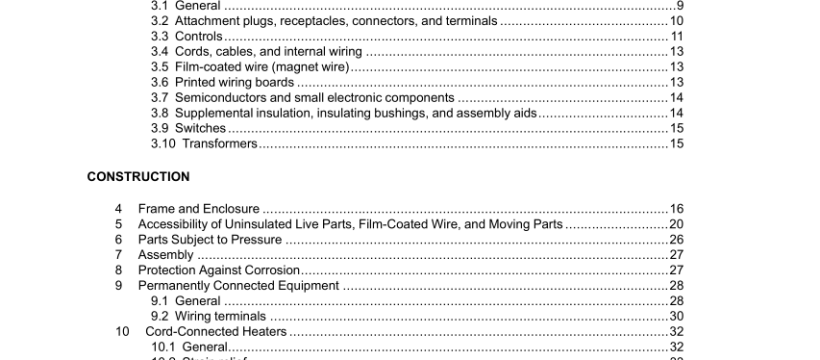UL 1042-2021 pdf download.Electric Baseboard Heating Equipment.
2A.2 APPLIANCE COUPLER – A single-outlet, female contact device for attachment to a flexible cord as part of a detachable power-supply cord to be connected to an appliance inlet (motor attachment plug). 2A.3 APPLIANCE INLET (Motor Attachment Plug) – A male contact device mounted on an end product appliance to provide an integral blade configuration for the connection of an appliance coupler or cord connector. 2A.4 APPLIANCE (FLATIRON) PLUG – An appliance coupler type of device having a cord guard and a slot configuration specified for use with heating or cooking appliances. 2A.5 COMPONENT – A device or fabricated part of the appliance covered by the scope of a safety standard dedicated to the purpose. When incorporated in an appliance, equipment otherwise typically field installed (e. g. luminaire) is considered to be a component. Unless otherwise specified, materials that compose a device or fabricated part, such as thermoplastic or copper, are not considered components. 2A.6 CONTROL CIRCUIT – A circuit that carries the electric signals directing the operation of a controller which, in turn, governs power delivered to a motor or other load. A control circuit does not carry the main power current. 2A.7 CORD CONNECTOR – A female contact device wired on flexible cord for use as an extension from an outlet to make a detachable electrical connection to an attachment plug or, as an appliance coupler, to an equipment inlet.
2A.8 TEMPERATURE CONTROLS – Devices that respond with a change in temperature (thermostatic devices) may be one of the following types: a) Regulating – Functions only to regulate the temperature of the heater under intended conditions of use, and whose malfunction would not result in a risk of fire. b) Limiting – Functions only under conditions that produce abnormal temperatures. The malfunction of such a device will result in a risk of fire. c) Auxiliary – Thermostatic device other than of the regulating or limiting type. d) Operating Control – A control intended to start or regulate the heater during normal operation. An example would be a temperature-regulating control. An operating control could provide Type 1 or Type 2 action. (See definitions 2A.9 – 2A.12). e) Protective Control – A control intended to reduce the risk of electric shock, fire, or injury to persons during abnormal operation of the heater. An example would be a temperature limiting control. A protective control always provides Type 2 action. (See definitions 2A.9 – 2A.12). 2A.9 TYPE 1 ACTION – Automatic action for which the manufacturing deviation and the drift of its operating value, operating time, or operating sequence have not been declared and tested to the Standard for Automatic Electrical Controls – Part 1: General Requirements, UL 60730-1. 2A.10 TYPE 2 ACTION – Automatic action for which the manufacturing deviation and the drift of its operating value, operating time, or operating sequence have been declared and tested to the Standard for Automatic Electrical Controls – Part 1: General Requirements, UL 60730-1. 2A.11 TYPE 2.H ACTION – So designed that the contacts cannot be prevented from opening and which may automatically reset to the closed position if the reset means is held in the reset position. The control shall not reset automatically at any temperature above -35 °C.
3.2 Attachment plugs, receptacles, connectors, and terminals 3.2.1 Attachment plugs, receptacles, appliance couplers, appliance inlets (motor attachment plugs), and appliance (flatiron) plugs, shall comply with the Standard for Attachment Plugs and Receptacles, UL 498. See 3.2.6. Exception: Attachment plugs and appliance couplers integral to cord sets or power supply cords that are investigated in accordance with the Standard for Cord Sets and Power Supply Cords, UL 817 are not required to complywith UL 498. 3.2.2 Female devices (such as receptacles, appliance couplers, and connectors) that are intended, or that may be used, to interrupt current in the end product, shall be suitably rated for current interruption of the specific type of load, when evaluated with its mating plug or connector. For example, an appliance coupler that can be used to interrupt the current of a motor load shall have a suitable horsepower rating when tested with its mating plug. 3.2.3 Multi-pole splicing wire connectors that are intended to facilitate the connection of hard-wired utilization equipment to the branch-circuit conductors of buildings shall comply with the Standard for Insulated Multi-Pole Splicing Wire Connectors, UL 2459. See 3.2.6.UL 1042-2021 pdf download.
UL 1042-2021 pdf download
